 Iran’s Attack on Israel
Iran’s Attack on Israel


13 min read
A brief history of these infamous factories of death.
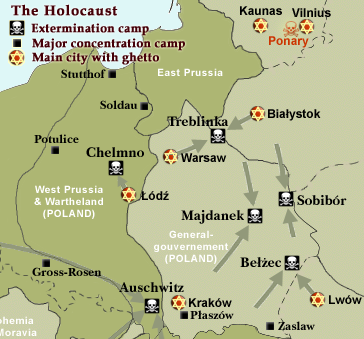 As soon as the Nazi party rose to power in 1933, it became common practice to intern anyone seen as a threat to the Party in concentration camps. The first of the inmates were “political prisoners” in the loosest sense of the term. These early camps were, in effect, prisons that provided the Reich with slave labour. Amongst the first to be opened were Dachau, located just outside of Munich (1933), and Sachsenhausen, a few miles north of Berlin (1936).
As soon as the Nazi party rose to power in 1933, it became common practice to intern anyone seen as a threat to the Party in concentration camps. The first of the inmates were “political prisoners” in the loosest sense of the term. These early camps were, in effect, prisons that provided the Reich with slave labour. Amongst the first to be opened were Dachau, located just outside of Munich (1933), and Sachsenhausen, a few miles north of Berlin (1936).
Although the camps built before the end of 1941 were supposedly intended to be labour or transit camps – designed to exploit, rather than exterminate their inmates – conditions in the camps were so brutal and inhumane, that the mortality rate was exceptionally high. Prisoners died from disease, malnutrition and exhaustion. Many were executed without due process, and some were subjected to medical experiments.
In the summer of 1941, Hitler ordered the “Final Solution to the Jewish question” – the extermination of all the Jews of Europe. Killing squads, known as Einstatzgruppen, followed the German army as it invaded the Soviet Union. In each newly conquered town or village, the entire Jewish community, including men, women, and children, was rounded up and marched to a nearby forest. There, they were forced to dig a large pit. After stripping off their clothing, they were shot into the mass grave.
The mobile death squads were considered too inefficient for killing large numbers of people. Shooting was too resource intensive for the Reich and too psychologically taxing on the murderers. Moreover, mass shootings attracted the attention of both the local populations and regular German soldiers, and rumours of the killings filtered back to Germany. As Hitler, wanted to hide his “Final Solution” from the German people and the world at large, an alternate plan for exterminating the large Jewish population of Poland was sought.
At the end of 1941, a new method of extermination was introduced in which victims were asphyxiated in the sealed compartment of a lorry into which carbon monoxide from the running engine was funnelled.
In 1941, the mobile killing squads murdered over a million Jews and thousands of Soviet partisans and Roma (Gypsies). However, the Germans estimated there were some 11 million Jews in Europe, and they sought to annihilate them all. A more efficient plan was needed.
These camps were intended for one purpose only: to facilitate genocide.
In January of 1942, top Nazi officials gathered at a resort on the shores of Lake Wannsee, near Berlin, to coordinate a network of “killing centres” where millions of Jews and other enemies of the German Reich could be executed efficiently and secretly. These death camps would differ in purpose and function from the existing concentration camps.
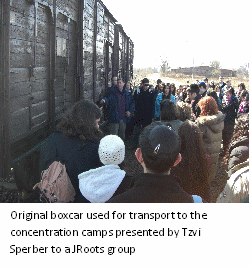
In late 1941 and early 1942, the Nazis opened five death camps in Poland: Belzec, Sobibor, Treblinka, Chelmno, and Auschwitz-Birkenau. These camps were not intended as labour camps, nor as prisons for punishing criminal actions. They were intended for one purpose only: to facilitate genocide – the annihilation of the Jewish People and other “undesirables.”
The death camps were quite literally factories of death. The vast majority of those who entered their gates were killed within hours of their arrival. Jews were transported to the camps by train and trucks. Upon their arrival, they were met by guards who explained that they would be bathed and disinfected before entering the camp. The Jews were forced to relinquish their valuables and to undress. The women’s hair was shaved. They were then crowded into sealed chambers into which poisonous gas was released, initially using the same carbon monoxide method as had been used in the mobile vans.
Execution was postponed for a few of the strongest and healthiest who were first exploited as slaves. These so-called Sonderkommando – literally, “special unit”, a term consistent with the Nazi practice of euphemism and deception – were forced to assist in the most dreadful of tasks such as removing their lifeless brethren from the gas chambers, and burning their bodies. The clothing, hair, and personal effects of the victims were collected and sorted by Sonderkommando, and then sent to Germany. Most of the victims of these camps were Jews, but many others, including many Roma (Gypsies), were executed as well.
The first death camp was opened on an abandoned estate in the town of Chelmno, about an hour northwest of Lodz. Its function was the liquidation of the substantial Jewish population of Lodz and its environs.
The SS and its auxiliaries began killing operations at Chelmno on 8 December 1941. The first people brought to the camp to be murdered were the 2,000 Jews who lived in the nearby town of Kolo. They were brought to Chelmno in stages by truck. Upon arrival, they were instructed to undress, and then were led out the back of the manor into the rear-end of a large lorry where they were asphyxiated by carbon monoxide. The lorry then transported the dead bodies to the forest where they were buried and later dug up and burned.
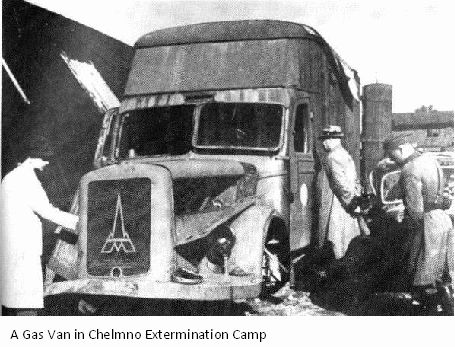
Beginning in January 1942, Jews were taken from the Lodz ghetto to their deaths at Chelmno. These included Jews from Germany, Austria, Bohemia, Moravia, and Luxemburg who had been interned in Lodz. Many Roma were sent to Chelmno as well. Although the facility was closed in March 1943, it was reopened in the summer of 1944 for the final liquidation of the ghetto.
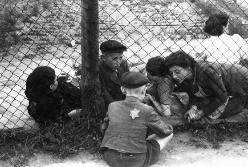 The secretary of the local council, Stanislaw Kaszynski, and his wife tried to bring public attention to what was being perpetrated at the camp. In late January, 1942, they were arrested, and executed three days later.
The secretary of the local council, Stanislaw Kaszynski, and his wife tried to bring public attention to what was being perpetrated at the camp. In late January, 1942, they were arrested, and executed three days later.
Family members say goodbye to a child through a fence at the ghetto's central prison where children, the sick, and the elderly were held before deportation to Chelmno during the "Gehsperre" action. Lodz, Poland, September 1942.
Operation Reinhard was the code name given to three extermination camps – Belzec, Sobibor, and Treblinka – established for the sole purpose of exterminating the approximately two million Jews then living in the General Government district (the unannexed part of Poland taken over by the Germans during World War II.) The guards in all three camps were Soviet prisoners of war or Polish civilians. The SS trained these guards to be ruthless killers.
Operation Reinhard ended in November 1943 – after almost all of Polish Jewry had been annihilated.
These camps were designed to hide their true function from both the outside world and their victims. The reception area and the killing centre (including gas chambers and mass graves) were separated by a narrow, enclosed passage known as “the tube.” After undressing and handing over their valuables, the prisoners were forced to run naked from the reception area through the tube into the gas chambers. The camps were surrounded by barbed wire fences interwoven with branches and surrounded by trees to camouflage them.
In 1943, the Sonderkommando in both Sobibor and Treblinka, revolted. Those few who managed to escape and evade recapture were virtually the only survivors of Operation Reinhard, which murdered some 1.7 million Jews between March 1942 and October 1943. Operation Reinhard ended in November 1943 – after almost all of Polish Jewry had been annihilated.
Concurrent with the latter phase of Operation Reinhard was “Aktion 1005” which was designed to remove all traces of the mass murders. In each camp, prisoners were forced to exhume mass graves and cremate the buried bodies, using giant grills made from wood and railway tracks. Afterwards, bone fragments were ground up in specialized milling machines and all remains were then re-buried in freshly-dug pits. For this reason, when visiting the Operation Reinhard camps, there is virtually nothing left to see of the camps themselves.
Originally established in 1940 as a labour camp, Belzec was converted to a death camp in late 1941, making it the first of the Operation Reinhard camps to go into operation. It would also serve as the model for the two others.
The wooden gas chambers were disguised as the barracks and showers of a labour camp, so that the victims would not realize the true purpose of the site. To pre-empt revolt, the process was conducted as quickly as possible: people were forced to run from the trains to the gas chambers, leaving them no time to absorb where they were or to plan a revolt. A handful of Jews were selected to be Sondercommandos who would perform all the manual work involved with extermination: removing the bodies from the gas chambers, burying them, sorting and repairing the victims' clothing, etc. These workers were periodically killed and replaced by new arrivals, so that they too could not organize a revolt.
Only two Jews are known to have survived Belzec: Rudolf Reder and Chaim Hirszman.
Between March and December 1942, approximately 434,500 Jews from Lvov, Lublin, and their surrounding areas, were murdered there. In total, the death camp operated for about 13 months during which a shocking 600,000 people were gassed. In the spring of 1943, the camp was dismantled and converted into a farm, which was tended by a former guard.
Only two Jews are known to have survived Belzec: Rudolf Reder and Chaim Hirszman.
Located in the Lublin district in eastern Poland, Sobibor was established in May 1942. Jews were transported to the camp from Lublin, Moravia, Moldavia, Slovakia, France, the Netherlands, and the ghettos of Belarus and Vilna.
The camp operated in a similar fashion to Belzec. Trains entered the railway station and the Jews onboard were told they were in a transit camp. They were forced to undress and hand over their valuables before being led along the 100-metre-long “Himmelstrasse” (Road to Heaven), which led to the gas chambers. There they were gassed using carbon monoxide released from the exhaust pipes of a dismounted tank engine.
Sobibor was the site of one of two successful uprisings by Jewish prisoners in Nazi extermination camps. There had been a similar revolt at Treblinka on 2 August 1943. (A revolt at Auschwitz-Birkenau in October 1944 led to one of the crematoria being blown up, but nearly all the escapees were killed.)
 On 14 October 1943, members of the Sobibor underground succeeded in covertly killing eleven German SS officers and a number of camp guards. The uprising began in the tailor shop and the shoemakers’ room where r the Commander in chief of the camp and the head of the Ukrainian guards were knocked out and relieved of their weapons. Although the plan was to kill all the SS and walk calmly out of the main gate of the camp, the killings were discovered and the inmates had to run for their lives under heavy machine-gun fire from guards.
On 14 October 1943, members of the Sobibor underground succeeded in covertly killing eleven German SS officers and a number of camp guards. The uprising began in the tailor shop and the shoemakers’ room where r the Commander in chief of the camp and the head of the Ukrainian guards were knocked out and relieved of their weapons. Although the plan was to kill all the SS and walk calmly out of the main gate of the camp, the killings were discovered and the inmates had to run for their lives under heavy machine-gun fire from guards.

Fewer than 300 out of the 500 prisoners in the camp succeeded in escaping to the forests. Many died in the minefields surrounding the site, and some were recaptured and executed by the Germans in the next few days. Only 50 to 70 escapees survived the war.
The day after the uprising, the camp was closed. Estimates of the number of Jews killed in Sobibor are as high as 250,000. There are very few survivors. Thomas “Toby” Blatt is one of them. He was the only living witness from Sobibor in the 2009/2010 Demjanjuk trial.
 In 1941, a labour camp was established near the town of Treblinka in northeast Poland. The camp continued to function until 1944. In July 1942, a death camp known as Treblinka II, together with the Warsaw-Bialystok railway line, were built near the labour camp. The two camps functioned under different authorities but worked in tandem; prisoners at the death camp who were selected for work were transferred to the labour camp, and prisoners of the labour camp who could no longer work were sent to the death camp.
In 1941, a labour camp was established near the town of Treblinka in northeast Poland. The camp continued to function until 1944. In July 1942, a death camp known as Treblinka II, together with the Warsaw-Bialystok railway line, were built near the labour camp. The two camps functioned under different authorities but worked in tandem; prisoners at the death camp who were selected for work were transferred to the labour camp, and prisoners of the labour camp who could no longer work were sent to the death camp.
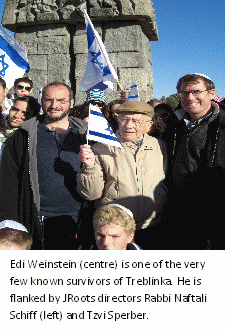
In the two months from July to September 1942, approximately 265,000 Jews were transported from the Warsaw ghetto to their deaths in Treblinka. From August to November of the same year, about 340,000 Jews were transported to Treblinka from the Radom district. Until May 1943, thousands more arrived at Tre
blinka from Bialystok, Greece, and Macedonia. In total, nearly 900,000 Jews were murdered at Treblinka between July 1942 and November 1943. Upon its closure in the fall of 1943, the Nazis destroyed the entire camp in an effort to conceal all traces of their crimes.
Auschwitz has come to symbolize the Holocaust. Its infamy derives from the sheer enormity of the “killing complex” and the number of people murdered there. Auschwitz was comprised of three camps and numerous sub-camps. The main camp, known as Auschwitz I, was opened in May 1940 as a concentration and labour camp.
Four new gas chambers using Zyklon-B were opened in early 1943.
The Nazis first experimented with the use of Zyklon-B in the Auschwitz gas chambers in the summer of 1941. Though certain targeted groups were gassed there, Auschwitz I remained, in essence, a concentration and labour camp. In the spring of 1942, a second camp, created within the Auschwitz complex, was designated as a killing centre, and was the final destination for all Jews from areas not included in Operation Reinhard. This camp was known interchangeably as Auschwitz II or Birkenau. Birkenau was originally equipped with two gas chambers. Four new gas chambers using Zyklon-B were opened in early 1943. Alongside the gas chambers were crematoria – ovens to burn the bodies.
Immediately upon their arrival at Auschwitz, the victims were subjected to a selection process. It was here that the notorious Doctor Mengele plied his murderous trade. Those selected for work were sent to one of its many associated labour camps. Those deemed unfit to work were immediately sent to the gas chambers.

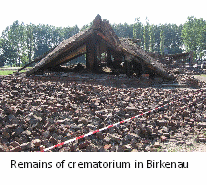 The conditions in the labour camps were unbearable, and prisoners who did not pass daily selections were gassed. Unlike the other death camps, Auschwitz-Birkenau itself functioned as both a concentration camp and an extermination camp. There were many individual acts of resistance and defiance by the prisoners; in October 1944, the Jewish Sonderkommando revolted, destroying one of the crematoria.
The conditions in the labour camps were unbearable, and prisoners who did not pass daily selections were gassed. Unlike the other death camps, Auschwitz-Birkenau itself functioned as both a concentration camp and an extermination camp. There were many individual acts of resistance and defiance by the prisoners; in October 1944, the Jewish Sonderkommando revolted, destroying one of the crematoria.
Between 1942 and 1944, transports of Jews arrived in Auschwitz from every part of Nazi-controlled Europe. Many Jews were transferred from other concentration camps to the killing centre at Birkenau. After the closure of the three Operation Reinhard camps in late 1943, Auschwitz-Birkenau was to be the final destination for all the remaining Jews of Europe.
All four gas chambers at Birkenau were put into round-the-clock use in the spring and summer of 1944 to wipe out Hungary’s Jews and the last survivors of the ghettos. At this point, up to 6,000 Jews a day were being put to death in each of them. By the time the gas chambers were destroyed in November 1944, over one million Jews had been murdered at Auschwitz, most of them immediately upon arrival. Tens of thousands of Poles, Roma, and prisoners of war were also killed there. The camp was liberated by the Soviets on 27 January 1945.
Excerpted from Triumph and Tragedy: Journeying Through 1000 Years of Jewish Life in Poland. The book includes more than two dozen biographical vignettes of Jewish Poland’s most significant personages, comprehensive, succinct profiles of the 24 most-visited sites of Jewish interest in Poland, and invaluable tools for understanding the Holocaust.
